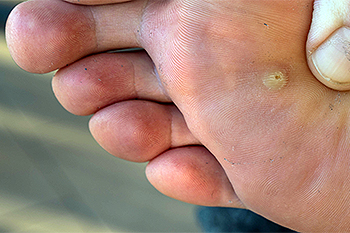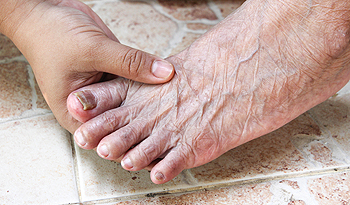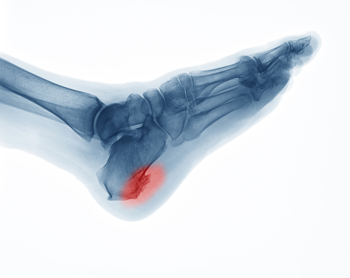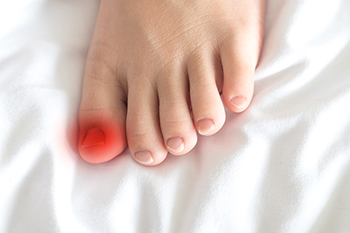Items filtered by date: July 2022
Plantar Warts May Be Rough or Smooth

Warts are skin growths and are caused by the human papillomavirus (HPV). It may take several months after coming in contact with the HPV to notice if warts have developed. They are known to be contagious and can spread by sharing towels, socks, or shoes. Plantar warts are located on the bottom of the feet and grow inward as a result of standing and walking all day. A plantar wart can be uncomfortable and can cause severe pain. Most people notice they look like a callus with tiny black dots in the middle, which are blood vessels. In other people, the wart may be smooth and flat. A proper diagnosis can consist of taking a sample of the wart and looking for any bleeding, a large size, or if they are fast-growing. Many warts will gradually disappear, although it is advised that if you have plantar warts you speak with a podiatrist who can properly treat them.
Plantar warts can be very uncomfortable. If you need your feet checked, contact Darren Day, DPM from Hawaii. Our doctor will assist you with all of your foot and ankle needs.
About Plantar Warts
Plantar warts are the result of HPV, or human papillomavirus, getting into open wounds on the feet. They are mostly found on the heels or balls of the feet.
While plantar warts are generally harmless, those experiencing excessive pain or those suffering from diabetes or a compromised immune system require immediate medical care. Plantar warts are easily diagnosed, usually through scraping off a bit of rough skin or by getting a biopsy.
Symptoms
- Lesions on the bottom of your feet, usually rough and grainy
- Hard or thick callused spots
- Wart seeds, which are small clotted blood vessels that look like little black spots
- Pain, discomfort, or tenderness of your feet when walking or standing
Treatment
- Freezing
- Electric tool removal
- Laser Treatment
- Topical Creams (prescription only)
- Over-the-counter medications
To help prevent developing plantar warts, avoid walking barefoot over abrasive surfaces that can cause cuts or wounds for HPV to get into. Avoiding direct contact with other warts, as well as not picking or rubbing existing warts, can help prevent the further spread of plantar warts. However, if you think you have developed plantar warts, speak to your podiatrist. He or she can diagnose the warts on your feet and recommend the appropriate treatment options.
If you have any questions please feel free to contact our offices located in Honolulu and Kahuku, HI . We offer the newest diagnostic and treatment technologies for all your foot and ankle needs.
How to Avoid Potential Foot Conditions in Elderly People

It is normal for the feet to flatten and become wider as the aging process occurs. As the fatty padding gradually wears down, the joints and bones of the feet are more susceptible to basic wear and tear. Range of motion and balance may be negatively affected, and injuries can happen more frequently. Foot care for the elderly can start with washing and drying the feet thoroughly every day, and this may be helpful in preventing bacterial, fungal , and viral infections. This is generally followed by applying a good moisturizer on the feet, which may help to prevent cracked heels from developing. Many people wear cotton socks after this, and this can help to lock in the moisture. When the toenails are properly trimmed, conditions that can include ingrown toenails may be avoided. Many elderly people are confined to a bed or chair for the majority of the day, and bedsores on the heels may develop as a result of this. This can be remedied by raising the heels in the air, which is known as “floating the heels’. There are additional ways that can help elderly patients take proper care of their feet, and it is suggested that you speak with a podiatrist to learn about these methods.
Proper foot care is something many older adults forget to consider. If you have any concerns about your feet and ankles, contact Darren Day, DPM from Hawaii. Our doctor can provide the care you need to keep you pain-free and on your feet.
The Elderly and Their Feet
As we age we start to notice many changes in our body, but the elder population may not notice them right away. Medical conditions may prevent the elderly to take notice of their foot health right away. Poor vision is a lead contributor to not taking action for the elderly.
Common Conditions
- Neuropathy – can reduce feeling in the feet and can hide many life-threatening medical conditions.
- Reduced flexibility – prevents the ability of proper toenail trimming, and foot cleaning. If left untreated, it may lead to further medical issues.
- Foot sores – amongst the older population can be serious before they are discovered. Some of the problematic conditions they may face are:
- Gouging toenails affecting nearby toe
- Shoes that don’t fit properly
- Pressure sores
- Loss of circulation in legs & feet
- Edema & swelling of feet and ankles
Susceptible Infections
Diabetes and poor circulation can cause general loss of sensitivity over the years, turning a simple cut into a serious issue.
If you have any questions please feel free to contact our offices located in Honolulu and Kahuku, HI . We offer the newest diagnostic and treatment technologies for all your foot and ankle needs.
Are Bunions Affecting Your Everyday Life?
What Causes Heel Spurs?

Protecting and caring for your heels is a critical component of maintaining proper foot health. However, a heel spur is a troublesome condition that can negatively impact your heels’ vigor. Heel spurs, also referred to as calcaneal spurs, are essentially bony bulges that form on the heel bone either on the back of the heel or under the sole of the foot. Heel spurs usually develop in response to plantar fasciitis and especially when stress is exerted on the plantar fascia for an extended period of time. Individuals who are middle-aged or overweight may be at an increased risk of developing this unfortunate foot affliction. Although some cases of heel spurs are asymptomatic and do not produce pain, many individuals with heel spurs can experience heel pain when beginning to walk after a period of rest. If you have a case of heel spurs, a podiatrist can help you address the condition. If your heel spurs are related to plantar fasciitis, they might be treated with orthotics such as night splints, heel inserts, or special footwear. When it comes to caring for your heels, it is highly suggested you consult with a podiatrist instead of taking chances.
Heel spurs can be incredibly painful and sometimes may make you unable to participate in physical activities. To get medical care for your heel spurs, contact Darren Day, DPM from Hawaii. Our doctor will do everything possible to treat your condition.
Heels Spurs
Heel spurs are formed by calcium deposits on the back of the foot where the heel is. This can also be caused by small fragments of bone breaking off one section of the foot, attaching onto the back of the foot. Heel spurs can also be bone growth on the back of the foot and may grow in the direction of the arch of the foot.
Older individuals usually suffer from heel spurs and pain sometimes intensifies with age. One of the main condition's spurs are related to is plantar fasciitis.
Pain
The pain associated with spurs is often because of weight placed on the feet. When someone is walking, their entire weight is concentrated on the feet. Bone spurs then have the tendency to affect other bones and tissues around the foot. As the pain continues, the feet will become tender and sensitive over time.
Treatments
There are many ways to treat heel spurs. If one is suffering from heel spurs in conjunction with pain, there are several methods for healing. Medication, surgery, and herbal care are some options.
If you have any questions feel free to contact our offices located in Honolulu and Kahuku, HI . We offer the latest in diagnostic and treatment technology to meet your needs.
Surgery and Ingrown Toenails

Ingrown toenails are considered to be a painful foot condition that occurs due to the nail growing into the skin instead of over it. Some of the symptoms that are associated with this ailment can include redness, swelling, and oozing if the toe becomes infected. Ingrown toenails may result from a toe injury or improperly trimming the nails. As the first symptoms appear, the toe may feel better when it is soaked in warm water and a piece of cotton is used to gently push the skin away from the nail. This is considered to be a temporary solution for mild relief. In severe cases, surgery may be necessary to perform which can permanently correct the nail. This procedure generally takes one hour and it is beneficial to have it performed at the end of the day followed by resting the foot. If you have recurring ingrown toenails it is suggested that you make an appointment with a podiatrist who can safely and effectively treat this condition.
Ingrown toenails may initially present themselves as a minor discomfort, but they may progress into an infection in the skin without proper treatment. For more information about ingrown toenails, contact Darren Day, DPM of Hawaii. Our doctor can provide the care you need to keep you pain-free and on your feet.
Ingrown Toenails
Ingrown toenails are caused when the corner or side of a toenail grows into the soft flesh surrounding it. They often result in redness, swelling, pain, and in some cases, infection. This condition typically affects the big toe and may recur if it is not treated properly.
Causes
- Improper toenail trimming
- Genetics
- Improper shoe fitting
- Injury from pedicures or nail picking
- Abnormal gait
- Poor hygiene
You are more likely to develop an ingrown toenail if you are obese, have diabetes, arthritis, or have any fungal infection in your nails. Additionally, people who have foot or toe deformities are at a higher risk of developing an ingrown toenail.
Symptoms
Some symptoms of ingrown toenails are redness, swelling, and pain. In rare cases, there may be a yellowish drainage coming from the nail.
Treatment
Ignoring an ingrown toenail can have serious complications. Infections of the nail border can progress to a deeper soft-tissue infection, which can then turn into a bone infection. You should always speak with your podiatrist if you suspect you have an ingrown toenail, especially if you have diabetes or poor circulation.
If you have any questions, please feel free to contact our offices located in Honolulu and Kahuku, HI . We offer the newest diagnostic and treatment technologies for all your foot care needs.






